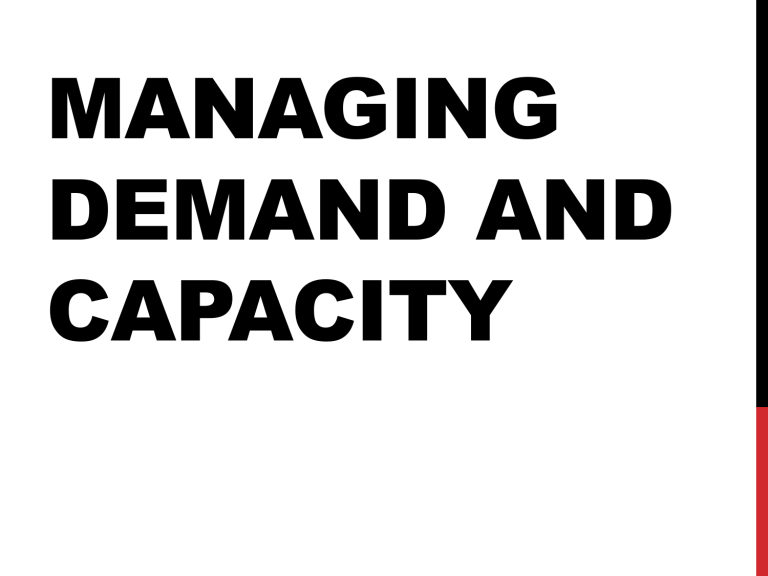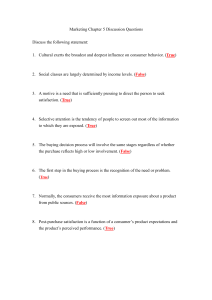
MANAGING DEMAND AND CAPACITY UNDERSTANDING CAPACITY CONSTRAINTS AND DEMAND PATTERNS Capacity constraints Time, labor, equipment and facilities Optimal versus maximal use of capacity Demand patterns Charting demand patterns Predictable cycles Random demand fluctuations Demand patterns by market segment CHART DEMAND/CAPACITY VARIATIONS DEMAND PATTERNS Marketers need to understand the pattern or way the demands behave, with respect to time, place and person. Then the relevant strategies can be developed. Sketching Demand Patterns : Companies need to keep a track record or log book, where all the demands are recorded on daily, weekly, monthly, seasonal, and yearly basis, and a graphical chart, sketch or a report can be made. After a few years, a set of patterns can be accurately predicted. Foreseeable / Predictable Cycles : Then some easily predicted or foreseeable cycle can be made. On that basis services can be planned. Ex. Health check-ups in hospitals Random Demand Variations : Some other service demands are not easily predictable, or they occur randomly, even if the cause can be ascertained. Say health care or insurance when a flood or earthquake occurs. Demand Patterns by Market Segments : Another more specialised database keeping is done for different demand pattern of customers of different segments. E.g., for a group of family the bonus time is holiday time, whereas for another group this is insurance premium pay time CAPACITY CONSTRAINTS Capacity of a company is defined as the ability to meet the demand and the extent to which it can do it. For production of goods this can be expanded or contracted easily. But for services it is difficult, as four critical factors are involved. This are done with utmost care, planning, cost effective measures. These are : • Time, Labour, • Equipment Facility Time • Time is limited and mostly specialised professionals have this constraints, they can’t take up more than the time permits and have to be idle if there are none.This can be tackled by business houses by opening shop for extended hours when the demand is more and vice versa. Say doctors can have more consulting hours when there is demand. The service providers must be willing to accept the change in situation. Labour • Labour or workers are another area of constraint. Beyond the full work load it’s hard to cater to more. On the other hand temporary employment is not available sufficiently in skilled category. • This can be tackled by out sourcing the workers to a contractors who has a large work force with him. • He can adjust between several companies, but again the difference in the skill is a bottleneck. Equipment • Like machinery, transport etc. are needed more in no. when there’s a bigger demand. For a limited period a company can’t buy extra equipment or machinery. • But these can be managed by careful planning – like having sufficient equipment for the minimum level in a cycle say a year with down/maintenance time, and out sourcing the additional demand by accurate prediction as far as possible. Facility • These are mostly the infrastructure like premises, building, hotel rooms, restaurant tables, class rooms, etc., which can’t be increased easily or quickly. • But to some extent they can be enhanced, like two shifts in the class rooms, adding a few tables and rearranging them in a restaurant, adding more compartments in a train, more flights for air travel, etc STRATEGIES FOR SHIFTING DEMAND TO MATCH CAPACITY Demand too high Use signage to communicate busy days and times. Offer incentives to customers for usage during non-peak times. Take care of loyal or “regular” customers first. Advertise peak usage times and benefits of non-peak use. Charge full price for the service--no discounts Demand too low •Use sales and advertising to increase business from current market segments. •Modify the service offering to appeal to new market segments. •Offer discounts or price reductions. •Modify hours of operation. •Bring the service to the customer. STRATEGIES FOR FLEXING CAPACITY TO MATCH DEMAND Demand too high Demand too low Stretch time, labor, facilities and equipment. Perform maintenance, renovations. Cross-train employees. Schedule vacations. Hire part-time employees. Schedule employee training. Request overtime work from employees. Lay off employees Rent or share facilities. Rent or share equipment. Subcontract or outsource activities. Outsource.
